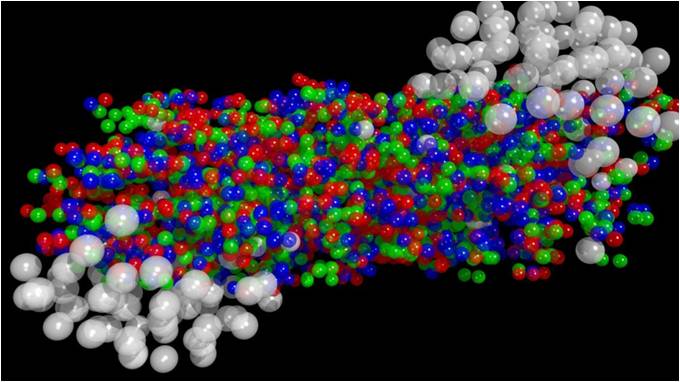In science, a new discovery can change the way we view something as large as the universe, or as small as an atom. Such was the case a few years ago, when the Large Hadron Collider (known as CERN) shook up the way particle theorists think.
“New technologies and experiments in the last decade enable us to measure things we could not before,” said Illinois State University’s Assistant Professor of Physics Allison Harris. The new discoveries at CERN and other particle accelerators have opened doors in physics—and Harris is leading the way through one of them.
Harris is creating theories to understand what happens when heavy particles—protons and other ions—collide with electrons in an atom. She recently received a grant of more than $100,000 from the National Science Foundation (NSF) to develop a new way to follow the path of these particles during and after collisions. The applications of her work are more than theoretical. A better, fundamental understanding of atoms can help support fields such as medical research.
Even before explaining her ideas, Harris is quick to point out she is talking about collisions happening at much slower speeds than the ones generated at CERN. “The people at colliders like CERN and Fermilab (Fermi National Accelerator Laboratory in Batavia, Illinois) are interested in smashing nuclei together and blowing them apart, which is cool,” she said with a laugh. “But I’m mostly interested in the electrons that are orbiting the nucleus in an atom, and what happens to them when they get kicked out. In ionization, things don’t have to move quite as fast.”
Ionization, or the booting of electrons from an atom, can occur in nature when atoms are bombarded with particles from the sun and outer space, said Harris. According to quantum mechanics, it is known that both electrons and heavy particles behave like waves. “But heavy particles tend to have less wavelike behavior than electrons,” said Harris, who added physicists are still exploring just how much heavy particle behavior deviates from classical physics.
“When it comes to shooting electrons at an atom, we are pretty good at figuring out where they go,” said Harris, who used the image of a set of billiard balls scattering after being hit by a cue ball. “But when it comes to shooting heavy particles at an atom, and figuring out where the electrons go?’ We’re not so good at that.”
In her grant, Harris proposes physicists use what is called a path-integral technique to follow the trajectories of the particles. “Instead of having a purely wave-like behavior, the particles might follow a more classical, curved path. There will still be some wave-like features, but these will be treated as corrections to the classical trajectory.”
According to Harris, the path-integral technique has been used in other areas such as high-energy physics and statistical mechanics, but no one has applied it to atomic collisions with heavy particles. “My idea is that maybe we can take this technique that has gained a lot of traction in other fields, and apply it over here. Hopefully we can learn something about how all of these particles interact.”
Understanding how atoms separate can assist in areas such as cancer therapy. “Already scientists are working on proton therapy for cancer patients, and are starting carbon therapy as well,” she said. “They want to kill the cancer cells, but leave everything else alone. To do that, we have to understand on a more fundamental level how these particles are interacting. The information we put together could help others to create models for their applications. The better we understand the fundamentals, the better their models can be.”


